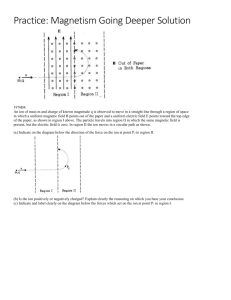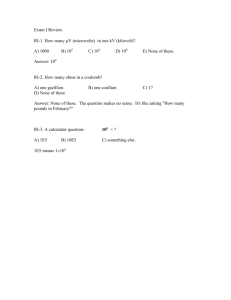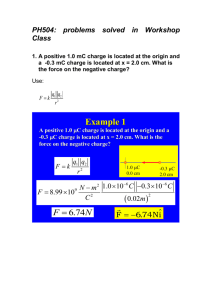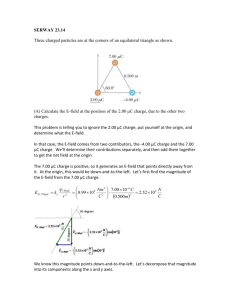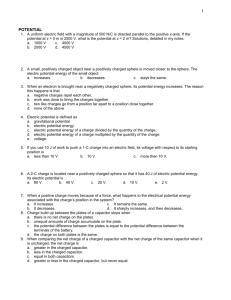Quiz 2 solutions April 25, 2012
advertisement
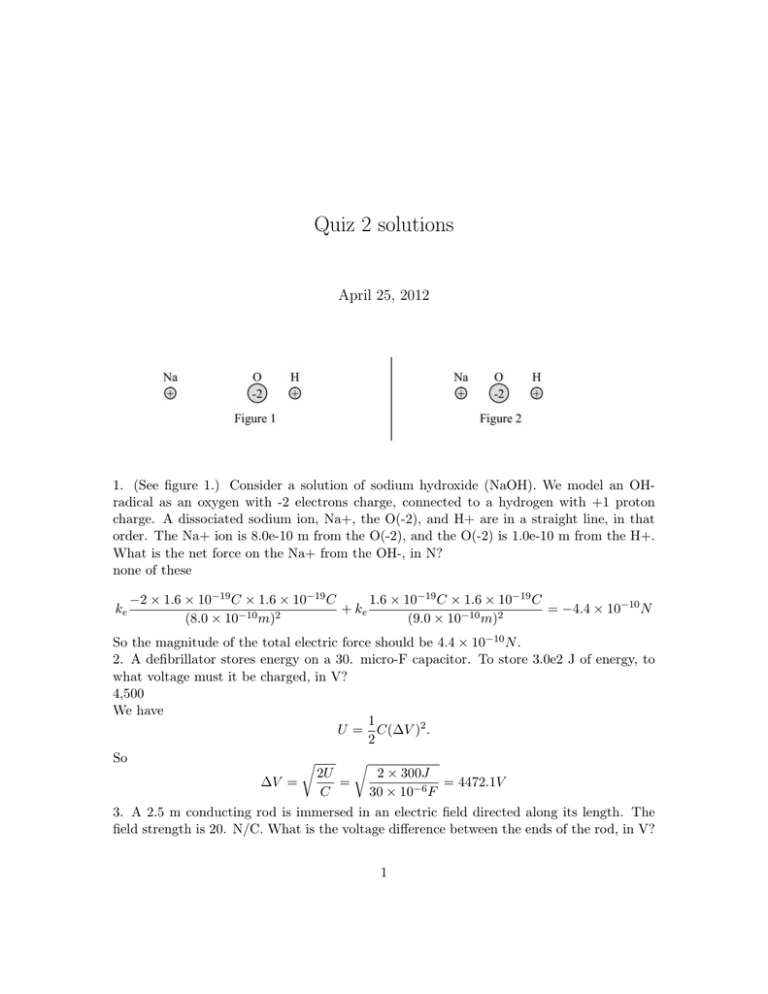
Quiz 2 solutions April 25, 2012 1. (See figure 1.) Consider a solution of sodium hydroxide (NaOH). We model an OHradical as an oxygen with -2 electrons charge, connected to a hydrogen with +1 proton charge. A dissociated sodium ion, Na+, the O(-2), and H+ are in a straight line, in that order. The Na+ ion is 8.0e-10 m from the O(-2), and the O(-2) is 1.0e-10 m from the H+. What is the net force on the Na+ from the OH-, in N? none of these ke −2 × 1.6 × 10−19 C × 1.6 × 10−19 C 1.6 × 10−19 C × 1.6 × 10−19 C + k = −4.4 × 10−10 N e (8.0 × 10−10 m)2 (9.0 × 10−10 m)2 So the magnitude of the total electric force should be 4.4 × 10−10 N . 2. A defibrillator stores energy on a 30. micro-F capacitor. To store 3.0e2 J of energy, to what voltage must it be charged, in V? 4,500 We have 1 U = C(∆V )2 . 2 So r r 2U 2 × 300J ∆V = = = 4472.1V C 30 × 10−6 F 3. A 2.5 m conducting rod is immersed in an electric field directed along its length. The field strength is 20. N/C. What is the voltage difference between the ends of the rod, in V? 1 0 Every point on the surface and in a charged conductor in electrostatic equilibrium is at the same potential. 4. A 30. micro-F capacitor is charged to 60 V. What is the E-field between its plates, in N/C? not enough information We can get total charge Q, but we still need to know the area of the plates A or the separation of the plates d to calculate the E-field. 5. (See figure 2.) A bound NaOH molecule is modeled as Na+ bound to O(-2) bound to H+, in a straight line in that order. The Na+ ion is 1.0e-10 m from the O(-2), which is 1.0e-10 m from the H+. How much energy does it take to remove the Na+ ion from the molecule (i.e., take it to far away), in J? The initial total electric potential energy is: Ui = ke −2 × 1.6 × 10−19 C × 1.6 × 10−19 C 1.6 × 10−19 C × 1.6 × 10−19 C +k = −3.5×10−18 J e 10−10 m 2.0 × 10−10 m To take them far apart, which means the final total electric potential energy Uf is zero, we need to do work W = 3.5 × 10−18 J. It is from the energy conservation(The work you do to separate them transforms into electric potential energy): Ui + W = Uf 6. A 0.0090 kg ball is placed in a downward E-field of 4.0e4 N/C. A charge on the ball keeps it stationary against gravity. What is the charge, in C? -2.2e-6 ~ = E(−ẑ). The charge is stationary means the total Let’s define upward as ẑ, so E-field E force is zero: Fe ẑ + mg(−ẑ) = 0, which means E(−ẑ)q = Fe ẑ = mgẑ so q= mg 0.0090kg × 9.8m/s2 = = −2.2 × 10−6 C −E −4 × 104 N/C 7. An electron in a picture tube starts at rest. It is accelerated by 25,000 V across a distance of 0.50 m to the screen. What is its energy when it hits the screen, in J? 4.0e-15 ∆KE = |∆U | = |q∆V | = 1.6 × 10−19 × 25000V = 4.0e − 15J 2 8. A capacitor has plates of area 2.0e-4 m2 , spaced 0.10 mm apart. It is charged to 5.0 V. What is the magnitude of the E-field between its plates, in N/C? 5.0e4 ∆V 5V = = 5 × 104 N/C d 0.1 × 10−3 m 9. q1 is 2 C; q2 is -4 C. They are spaced so that q1 pulls on q2 with 2.5 N. What is the force of q2 on q1 ? pulls with 2.5 N Because two charges have different signs, they pull each other with same amount of force. E= q1 q2 F~12 = ke 2 r̂12 = −2.5N r̂12 r q1 q2 F~21 = ke 2 r̂21 = −2.5N r̂21 r Actually you can get the same answer just through Newton’s 3rd Law. 10. An electron in a picture tube starts at rest. It is accelerated by 25,000 V across a distance of 0.50 m to the screen. How long does it take to travel to the screen, in s? 1.1e-8 Because the electron starts at rest, so we have 1 d = 0.5m = at2 , 2 where a is the acceleration due to the electric force Fe = Eq = me a, so s r 2d 2d = t= , a Eq/me and we can get E from E = ∆V /d, so s r 2d × d × me 2 × 0.5m × 0.5m × 9.1 × 10−31 kg = = 1.1 × 10−8 s t= ∆V q 25000V × 1.6 × 10−19 C 3


